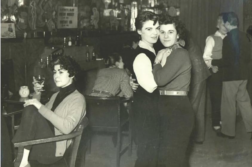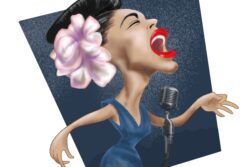Queer Youth in the Province of the “Severe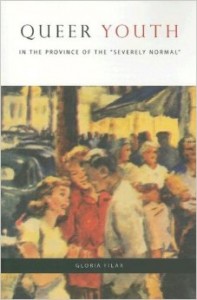 ly Normal”
ly Normal”
by Gloria Filax
U. of British Columbia Press. 180 pages, 29.95
Grounded in social science research and informed by contemporary queer theory, Queer Youth is a highly readable piece of scholarship that looks closely at the experiences of young sexual minorities living in 1990’s Alberta, Canada. Blending ethnographic methods with discourse analysis, Filax traces the processes of constructing and negotiating queer youth identities in relation to dominant or competing ideas about gender, sexuality, and youth. Ultimately, Filax argues that the young people she interviewed for the book constitute a distinct counter-discourse that challenges the prevailing homophobic narratives. Filax begins by analyzing the cultural impact of the medical category Gender Identity Disorder (GID) as listed in the Diagnostic and Statistic Manual of Mental Disorders, the official listing of mental illness published by the American Psychiatric Association, which serves as a guide for experts to psychopathologize youths whose behavior doesn’t correspond to their biological sex. Filax demonstrates that the presumed normative relationship between sex and gender in these diagnostic criteria contain a deeper layer of heterosexist assumptions. Within this clinical category of GID, queer youths thus inhabit “troubling identities” based on their non-conforming gender orientation. After looking at how the category of GID reinforces gender rigidity and heterosexuality, Filax studies the production of the category “youth” in social science research. Comparing mainstream youth studies and queer youth studies, she finds that the former “pays little to no attention to the social conditions sexual minority youth encounter in schools.” In contrast, queer youth studies emphasize the various homophobic institutions that regulate the lives of sexual minorities.
Howard Chiang
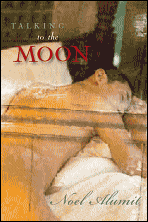 Talking to the Moon
Talking to the Moon
by Neil Alumit
Carroll & Graf. 340 pages, $14.95 (paper)
Filipino magic realism meets gay America in this fascinating and well-written novel of life on the fringes of Los Angeles. Emerson (named for Ralph Waldo) Lalaban is the gay son, aimless and undereducated, trying to figure out how to have a relationship with another Asian man, Michael, without talking about love. Michael, who flies in and out of L.A. frequently as a Taiwanese airline steward, believes that Emerson looks exactly like Andy Lau, a wildly popular Asian entertainer. Emerson’s daily life is sometimes interrupted by phone calls from his older brother Jun, who had died as a child. Jun sometimes calls just to chat, other times to offer advice. Emerson’s champion—his father, Jory—is not just a postal carrier, but also an animist and shaman. Alumit’s descriptions of country life in the Philippines just after World War II are intriguing and leave one eager to know more. Emerson’s mother, Belen, a fervent Catholic to whom the Virgin Mary regularly speaks, can’t cope with Emerson’s gayness or her ghastly feeling that the “wrong son” died. Belen herself was disowned as a teenager for falling in love with Jory when he was training for the priesthood, and married him when he renounced that career path; she evolves throughout the novel and emerges as an entirely likeable character. This is Neil Alumit’s second novel and is loosely based upon an actual event that took place in August 1999, when a white supremacist shot a Filipino postal carrier and opened fire at an L.A. Jewish community center.
Martha E. Stone
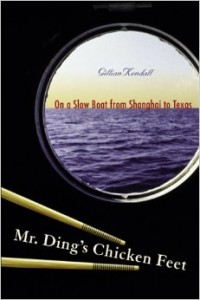 Mr. Ding’s Chicken Feet: On a Slow Boat from Shanghai to Texas
Mr. Ding’s Chicken Feet: On a Slow Boat from Shanghai to Texas
by Gillian Kendall
U. of Wisconsin Press. 256 pages, $22.95
This book chronicles the author’s six weeks of sea teaching English to Chinese sailors on a small cargo ship from Shanghai to Galveston, Texas. There are some wonderfully vivid vignettes, such as her description of a storm at sea and the seabirds that “were shrieking, circling around, fighting the wind. Some tried to land on the water, but they’d be dashed by the waves and would ascend again, wet and squawking.” The story takes place in 1991. Although China’s politics are not explicitly dealt with, the attitudes of the sailors in their interaction with Kendall when she comes across a photo of some of them in a Communist Party meeting is revealing. The students are cheerful and willing to discuss family and popular culture, but when the conversation veers toward the political, they become nervous and reticent. This clashing of cultures is what drives the book forward as Kendall gains new insights into both herself and her students. Mr. Ding’s Chicken Feet is an inner voyage as well. Part of the book deals with Kendall’s growing ambivalence toward a boyfriend back home and her emerging lesbianism. She might have gone deeper here: the issue is never really resolved and one wonders what will happen when she returns to shore. The heart of the book, however, lies in the developing relationship between Kendall and the all-male crew as they navigate the ocean as well as their understanding of two cultures.
Leslie J. Clary



